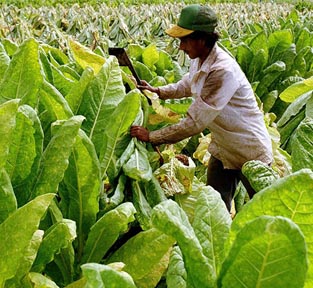Tobacco Farmers Battling Weather, Labor Shortages
Tobacco Farmers Battling Weather, Labor Shortages

Kentucky’s tobacco producers are trying to finish harvesting a tobacco crop that enjoyed good growing conditions much of the year, but labor shortages and weather delays are putting a damper on the process.
“With the ongoing debate over immigration reform and increased competition for workers from other job markets, the pool of migrant workers available to tobacco growers has shrunk considerably,” said Bob Pearce, a tobacco specialist with the University of Kentucky College of Agriculture. “Workers were available in most areas but not in sufficient numbers to harvest the tobacco crop in a timely manner.”
Tobacco growers across the state dealt with labor shortages, perhaps more so in central Kentucky. In western Kentucky, labor arrived a couple weeks later than usual, and sometimes there were a few less workers than expected, said Andy Bailey, a UK tobacco specialist based at UK’s research center in western Kentucky.
Most farmers in western Kentucky use a federal guest worker program called the H2A Program, which sets specific guidelines farmers and the workers must follow. Because of increased border scrutiny, the process took longer than usual and some workers were turned back, Bailey said.
“I haven’t had anybody say they couldn’t get them (workers), but they have come late,” he said. “The problem now is getting the weather to cooperate.”
Weather has compounded the labor issues by limiting the number of days available for harvest. With burley tobacco, long periods of overcast days kept growers out of the fields. When they were able to return to harvest, the tobacco was often wet and brittle, resulting in high harvest losses, Pearce said. Rain on cut tobacco will also result in more dirt and mud than usual on the crop and will further reduce quality.
“The ideal time to harvest burley tobacco is about three and a half to four weeks after topping,” he said. “During the 2006 growing season, it was not uncommon to see crops still standing six to eight weeks after topping.”
A later harvest results in more suckering and potentially reduced leaf quality.
In western Kentucky, farmers generally try to harvest their burley tobacco first then move on to their dark tobacco crop.
“Dark tobacco requires extensive wilting in the field before it can be put on a stick and housed,” he said. “We’ve had cloudy days where it’s taken it much longer to wilt. A lot of guys have had to cut it down in the afternoon and leave it overnight and take the chance of it getting rained on. Under normal conditions, we can cut some late morning and have it up by late afternoon.”
Continued wet conditions and cool temperatures could make the curing process also a trying time for producers. Tobacco that does not cure properly can house burn or cure green, leaving the leaf less than optimal for the manufacturers. Having proper air flow and temperatures for burley and dark air-cured tobacco are vital for good quality leaf. Temperatures are not as vital in fire-cured dark tobacco.
Despite the labor and harvest challenges, this year’s crop continues to have the potential to be a good yielding crop. To get the most of out of their 2006 efforts, growers need to allow the crop to cure completely then carefully separate the leaf into grades according to the guidelines of the company they have a contract with, Pearce said.
And as farmers look to 2007, they need to take a lesson from this year’s labor shortage. For next season, growers should consider the expected harvest crew size they will have and try to space out transplanting in hopes that the crop can be harvested closer to the ideal time, Pearce said.